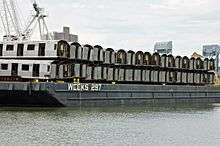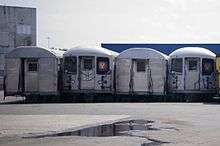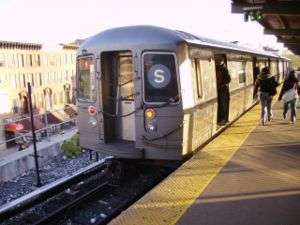R42 (New York City Subway car)
| R42 | |
|---|---|
|
An R42 train on the | |
|
Interior of R42 car 4573. | |
| In service | 1969-present |
| Manufacturer | St. Louis Car Company |
| Built at | St. Louis, Missouri, USA |
| Replaced | All remaining BMT Standards, and many R1s |
| Constructed | 1969–1970 |
| Refurbishment | 1988–1989 |
| Scrapped |
2007-2008 (NYCTA-rebuilt cars) 2009-2013 (most MK-rebuilt cars) TBD (remaining cars) |
| Number built | 400 (most retired) |
| Number in service | 50 |
| Number preserved | 5 |
| Number scrapped | 345 |
| Formation | Married Pairs |
| Fleet numbers | 4550–4949 |
| Capacity | 44 (seated) |
| Operator(s) | New York City Subway |
| Depot(s) | East New York Yard (50 cars)[1] |
| Service(s) assigned |
|
| Specifications | |
| Car body construction | Stainless Steel with Carbon Steel chassis, roof and underbody, Fiberglass A-end bonnet and B-end top bonnet |
| Train length |
2 car train: 120.4 feet (36.7 m) 4 car train: 240.8 feet (73.4 m) 6 car train: 361.2 feet (110.1 m) 8 car train: 481.6 feet (146.8 m) 10 car train: 602 feet (183 m) |
| Car length | 60 ft (18.29 m) |
| Width | 10 ft (3,048 mm) |
| Height | 12.08 ft (3,682 mm) |
| Platform height | 3.76 ft (1.15 m) |
| Doors | 8 |
| Maximum speed | 55 mph (89 km/h) |
| Weight | 74,388.5 lb (33,742 kg) |
| Traction system |
General Electric (GE) SCM propulsion system using Westinghouse 1447J motors 115 hp (85.8 kW) on all axles |
| Electric system(s) | 600 V DC Third rail |
| Current collection method | Contact shoe |
| Braking system(s) |
CI Rebuilds: New York Air Brake SMEE/ Newtran (dynamic and friction), A.S.F. simplex unit cylinder clasp (tread) brake MK Rebuilds: WABCO "SMEE" Braking System, A.S.F. simplex unit cylinder clasp (tread) brake |
| Coupling system | Westinghouse H2C |
| Headlight type | halogen light bulbs |
| Track gauge | 4 ft 8 1⁄2 in (1,435 mm) |
The R42 is a New York City Subway car model built between 1969 and 1970 by the St. Louis Car Company in St. Louis, Missouri for the (IND/BMT) B Division. It was the last 60-foot (18.29 m) B Division car built for the New York City Subway until the R143 in 2001, and the last car model class to be built in married pairs.
Description
The R42s are numbered 4550–4949.
The R42s were the first fleet of New York City Subway cars to be fully equipped with Stone Safety 10 ton air conditioning systems/units. Such units were similarly found on the last ten R38s (4140-4149) and all R40As.
The R42s were also the first cars to use solid state converters in place of the motor-generators as standard equipment.
Although there were some slight cosmetic differences between the R42s and straight-ended R40As (such as the blind end storm doors and the side appearance of the body), the two cars were, for all practical purposes, the same car type. The straight-ended R40As and R42s often ran together, and one R42 was even mated to an R40M due to an accident on the Williamsburg Bridge on June 6, 1995.
History
On May 9, 1969, cars 4554-4555 entered service on the N as part of a mixed consist with straight-ended R40As. By January 5, 1970, all cars were in service.[2]
Maintenance and overhauls
In 1974, cars 4650-4659 and 4760-4769 were sent to Garrett AiResearch's facilities in Los Angeles, California to test out Flywheel Energy Storage System equipment.[3] The even-numbered cars received energy conservation machinery with batteries and amber-type digital readouts indicating the amount of energy used by the equipment, while the odd-numbered cars remained untouched. These cars were later tested at the UMTA, and the USDOT Testing Facilities in Pueblo, Colorado for evaluation, and were returned to the MTA in 1976 for in-service testing on all BMT/IND Lines to check the effectiveness of the technology.
In 1977, pantograph gates, salvaged from retired R1 through R9 cars, were modified and then installed on the front ends of the R42 and R40A straight-ended cars, and baloney coiled spring type inter car safety barriers were installed on the blind ends of the married pairs (the straight-ended R40As came factory equipped with the baloney coiled spring type inter car safety barriers on their blind ends, and so did not need such installations).
Between 1988 and 1989, the R42s underwent overhaul as a result of deferred maintenance in the New York City Subway during the 1970s and the 1980s. 282 cars (4550–4839) were overhauled by Morrison-Knudsen while the last 110 cars (4840–4949) were rebuilt in-house by the Coney Island Overhaul Shop in Brooklyn. The one minor difference in appearance between the two overhauls was that many cars of the Coney Island version featured the original blue door indicator lights at the ends of the cars, whereas these lights were removed from the Morrison-Knudsen rebuilds. Coney Island cars retained original Westinghouse XM829 master controllers in their cabs.
Mishaps
Cars 4680-4681, 4714-4715, and 4766-4767 were scrapped in 1988 due to damage sustained in various accidents during the 1980s.
On June 6, 1995, cars 4664-4665 were involved in a collision on the Williamsburg Bridge. Car 4664 was scrapped in 2000 (along with cars 4685 and 4726, which were not involved in the accident), while 4665 was mated with straight-ended R40A car 4460, which lost its mate in the same accident.
On November 6, 2007, an M train of R42s was involved in an accident when the motorman attempted to relay it south of the Chambers Street station. As the R42 fleet was being retired at the time, the entire consist[4] was hauled to the 207th Street Yard for reefing instead of being repaired even though only the first two cars suffered major damage.[5][6]
Initial plans for retirement and preservation


The R160s replaced most of the R42 fleet from 2007 to 2009. They were intended to replace the entire fleet, but this has been halted due to structural issues found on the R44s that led to a premature retirement of that fleet. The NYCT-rebuilt R42s were retired and reefed first, from late 2007 to mid-2008. Subsequently, most Morrison-Knudsen-rebuilt cars followed starting in late 2008 until December 2009, when it was decided to retire the NYCT R44s instead.[7] All but 50 cars were retired, and most were stripped and sunk as artificial reefs.
However, after the reefing program ended in April 2010, retired R42s have been trucked to Sims Metal Management's Newark facility to be scrapped and processed, an action that occurred between April 2013 and July 2013 with already-retired cars and is expected to occur with the remaining in-service cars when they retire.[8]
No NYCT-rebuilt R42s were preserved. However some Morrison-Knudsen-rebuilt R42 cars were saved for various purposes throughout the New York City Subway system, including:
- 4572-4573 - preserved, repainted, and set aside for the New York Transit Museum. This set was used in the famous chase scene in the film The French Connection. The cars have been used on several recent NYCTM fan trips, including the BMT 100th Anniversary special, specifically as a part of the Train of Many Metals. [9]
- 4665 - preserved by the Railway Preservation Corp with its straight-ended R40A mate 4460. The pair is stored at Coney Island Yard and has seen some light cosmetic work.
- 4736-4737 - donated to East New York's Transit Tech High School[10] on April 14, 2009, replacing R30 car 8337, which was reefed a few months later.[11]
Prolonged service
The 50 cars still in service, 4788-4817 and 4820-4839, are assigned to East New York Yard, operating on the J and Z. They are 47 years old and are the second oldest subway cars in service, behind the R32s built in 1964-1965. These cars are now expected to be replaced by the R179s in the future.
See also
R40A (New York City Subway car) - 100 of these cars are similar to the R42. They were also built by St. Louis Car Company.
References
- ↑ New York Subway Barn Assignments – November 6, 2016
- ↑ ERA New York Division Bulletin, August 2005 "January 5, 1970 Car Assigment", Page 9.
- ↑ http://www.nycsubway.org/perl/show?26969
- ↑ Cars #4730, 4731, 4624,4625, 4818,4819, 4786, and 4787
- ↑ "MTA - Press Release - NYC Transit - M Train Incident at Chambers Street". mta.info.
- ↑ "www.nycsubway.org". www.nycsubway.org.
- ↑ https://docs.google.com/spreadsheets/u/1/d/1l6kZ05gU-4fMhf5rc9GX5igW6d97vq9_nn0WSJkNTxM/pub?single=true&gid=4&output=html
- ↑ "Showing Image 140235". nycsubway.org.
- ↑ http://www.nycsubway.org/perl/show?144505
- ↑ Mooney, Jake (May 3, 2009). "Very Closely Watched Trains". The New York Times. New York, NY. p. CY1.
- ↑ "www.nycsubway.org". www.nycsubway.org.
Further reading
- Sansone, Gene. Evolution of New York City subways: An illustrated history of New York City's transit cars, 1867-1997. New York Transit Museum Press, New York, 1997 ISBN 978-0-9637492-8-4
External links
| Wikimedia Commons has media related to R42 (New York City Subway car). |
- nycsubway.org - NYC Subway Cars: R42
- BMT-IND Car Assignments – November 6, 2016
- New York City Subway Car Fleet June 2010 through November 2016




